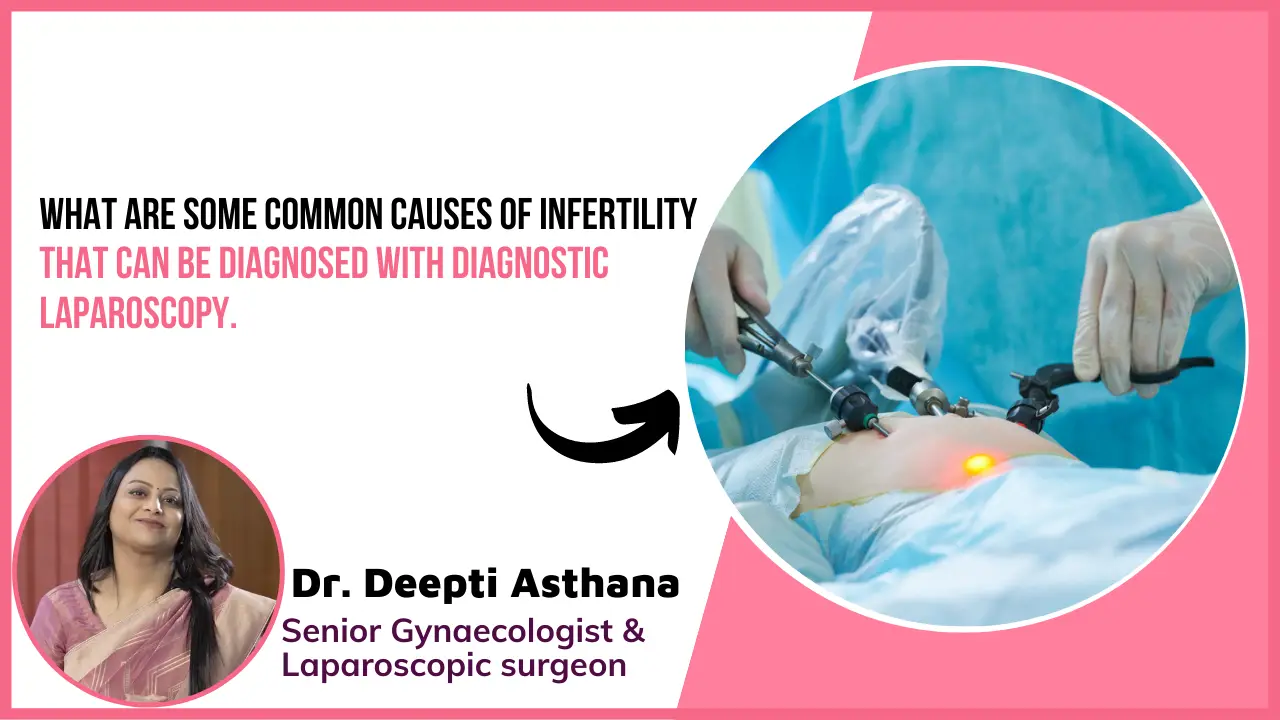
Table of Contents
Infertility is a common issue affecting millions of couples worldwide. In India, around 10-15% of couples struggle with infertility. Infertility can be caused by several factors, including male infertility, ovulation disorders, and tubal infertility. In some cases, infertility is unexplained, and the cause cannot be identified. However, in many cases, a diagnosis can be made using diagnostic laparoscopy. In this article, we will discuss some common causes of infertility that can be diagnosed with diagnostic laparoscopy, as explained by Dr. Deepti Asthana, Senior gynaecologist and laparoscopic surgeon.
What is Diagnostic Laparoscopy?
Diagnostic laparoscopy is a minimally invasive surgical procedure that allows a doctor to view the inside of the abdomen and pelvis using a thin, lighted instrument called a laparoscope. The laparoscope is inserted through a small incision in the abdomen, and images of the organs and tissues are transmitted to a video monitor. Diagnostic laparoscopy is often used to evaluate and diagnose infertility.
Common Causes of Infertility Diagnosed with Diagnostic Laparoscopy
Endometriosis
Endometriosis is a condition in which the tissue that normally lines the inside of the uterus grows outside of it, causing inflammation, scarring, and adhesions. Endometriosis can cause infertility by interfering with the normal function of the ovaries, uterus, and fallopian tubes. Laparoscopy is the gold standard for diagnosing endometriosis, as it allows a doctor to see the extent of the disease and remove any endometriosis implants or adhesions that may be causing infertility.
Pelvic Inflammatory Disease (PID)
PID is an infection of the female reproductive organs, including the uterus, fallopian tubes, and ovaries. PID can cause scarring and adhesions in the fallopian tubes, making it difficult for eggs to travel from the ovaries to the uterus. Diagnostic laparoscopy can be used to diagnose PID by visualizing the inflammation and scarring in the reproductive organs. Treatment for PID typically involves antibiotics, and surgery may be necessary in severe cases.
Tubal Factor Infertility
Tubal factor infertility is a type of female infertility caused by damage to the fallopian tubes. The fallopian tubes play a crucial role in fertilization, as they transport eggs from the ovaries to the uterus. Tubal factor infertility can be caused by a variety of factors, including PID, endometriosis, and previous abdominal surgeries. Diagnostic laparoscopy can be used to visualize the fallopian tubes and assess their function. In cases of severe tubal damage, in vitro fertilization (IVF) may be recommended.
Ovarian Cysts
Ovarian cysts are fluid-filled sacs that form on the ovaries. Most ovarian cysts are benign and do not cause symptoms, but in some cases, they can interfere with ovulation and cause infertility. Diagnostic laparoscopy can be used to visualize and remove ovarian cysts that may be interfering with fertility.
Uterine Fibroids
Uterine fibroids are noncancerous growths that develop in the wall of the uterus. Fibroids can cause infertility by interfering with the implantation of a fertilized egg or by blocking the fallopian tubes. Diagnostic laparoscopy can be used to remove fibroids that are causing infertility.
Adhesions
Adhesions are bands of scar tissue that form between organs and tissues in the abdomen and pelvis. Adhesions can cause infertility by blocking the fallopian tubes or interfering with the normal function of the ovaries and uterus. Diagnostic laparoscopy can be used to visualize and remove adhesions that may be causing infertility.
Polycystic Ovary Syndrome (PCOS)
PCOS is a common hormonal disorder that affects women of reproductive age. Women with PCOS may have multiple cysts on their ovaries, irregular periods, and high levels of male hormones. PCOS can cause infertility by interfering with ovulation. Diagnostic laparoscopy can be used to visualize the ovaries and assess their function. Treatment for PCOS typically involves medication to regulate ovulation.
Unexplained Infertility
In some cases, the cause of infertility cannot be identified despite thorough testing and evaluation. This is known as unexplained infertility. Diagnostic laparoscopy can be used to visualize the reproductive organs and rule out any structural abnormalities that may be causing infertility.
Infertility can be a frustrating and emotional experience for couples trying to conceive. However, advances in medical technology and diagnostic procedures like laparoscopy have made it possible to identify and treat many of the underlying causes of infertility. If you are struggling with infertility, it is important to seek the advice of a qualified healthcare professional like Dr. Deepti Asthana, who can provide a thorough evaluation and personalized treatment plan. With the right diagnosis and treatment, many couples are able to successfully overcome infertility and start their families.



Leave a Reply